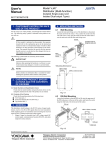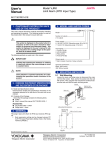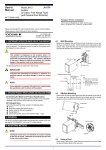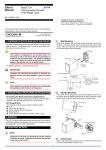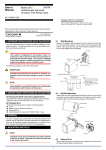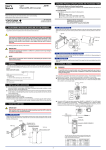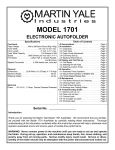Download User`s Manual
Transcript
User’s Manual IM 77J01H07-01E Model VJH7 Isolator (Multi-function) (Isolated Single-output and Isolated Dual-output Types) 1. CAUTIONARY NOTES FOR SAFE USE OF THE PRODUCT For the correct use of this product, read through this manual before use. The following safety symbol is indicated on the product to ensure safe use. 4. MOUNTING METHODS 4.1 Wall Mounting Loosen the main unit-fixing screw of the isolator to disconnect the main unit from the socket. Next, anchor the socket onto the wall with screws. Then, plug the main unit into the socket and secure the main unit with the main unit-fixing screw. CAUTION Socket If this symbol is indicated on the product, the operator should refer to the explanation given in the instruction manual in order to avoid personnel injury or death to either themselves or other personnel, and/or damage to the instrument. The manual describes the special care the operator should exercise to avoid shock or other dangers that may result in injury or loss of life. Threaded hole for fixing the main unit Main unit Main unit-fixing screw Mounting screws The following symbol marks are used only in this manual. IMPORTANT Indicates that operating the hardware or software in a particular manner may damage it or result in a system failure. <Mounting Dimensions> Unit: mm 29.5 or more 22±0.2 2-M4 or 2-ø4.5 or more NOTE 2. CHECKING PRODUCT SPECIFICATIONS AND THE CONTENTS OF PACKING (1) Model Number and Specification Check Check that the model number and specifications shown on the nameplate attached on the side of the product are as ordered. (2) Contents of the Packing Check that the packing contains the following items: ● VJH7 main unit, 1 ● Instruction Manual (IM 77J1H07-01E), 1 59±0.3 Draws attention to information that is essential for understanding the operations and/or features of the product. Fig. 4.1 4.2 DIN Rail Mounting Locate the isolator so that the DIN rail fits into the upper part of the DIN-rail groove at the rear of the socket, and fasten the socket using the slide lock at the lower part of the socket. DIN rail Accessories: ● Tag number label, 1 ● Renge label, 1 ● Shunt registor (for specification of current input), 1 W VIE A VIEW A (Rear of socket) 3. GENERAL This plug-in isolator, which belongs to the JUXTA series of signal conditioners, receives DC current or voltage signals and converts them to pairs of isolated DC voltage or current signals. • Output-2 signal is selectable from a DC voltage signal, DC current signal, communication function (RS-485), and alarm output (two relay contacts). DIN rail Slide lock Fig. 4.2 Keep this manual in a safe place. Network Solutions Business Divisiion 2-9-32, Naka-cho Musashino-shi, Tokyo 180-8750 Japan Phone: +81-422-52-7179 Facsimile: +81-422-52-6793 IM 77J01H07-01E 1st Edition Nov. 1999 2nd Edition June 2004 2 4.3 Mounting Using a Multi-mounting Base • For mounting using a multi-mounting base, see the Instruction Manual for VJCE (VJ Mounting Base). 4.4 Using Ducts Wiring ducts should be installed at least 30 mm away from the top or bottom of the main unit. 4.5 In case of top-and-bottom close mounting • For mounting, use M3 screws and crimp-on terminals with insulating sleeves appropriate for the wires used. Tool of the crimp-on terminals to be used should be appropriate for the crimp-on terminals. Mount a breaker on the external place. Mount a switch or 5A circuit breaker on the place near by the instrument, within operator’s reach. And attach the indication that it is for disconnecting the instrument. Transmitter should be mounted horizontally with its top and bottom slits being vertical. The top and bottom slits should not be covered. The area for wiring is required above and below the transmitter (the area with slant lines). Input signal Analog input + R 40 or more - ALM1 ALM1 ALM2 ALM2 ALM2 (72) ALM1 Shunt resistor (Externally connected for current input) Output-2 signal 78 or more 150 or more 6 2 1 5 4 (29.5) Analog output Alarm output 2 5 + 2 - 5 29.5 or more 6 9 ALM1 ALM1 ALM2 ALM2 ALM2 8 ALM1 COM ALM2 RS-485 communication 2 B+ 5 A- 6 COM 7 Output-1 signal (72) ALM1 11 10 Analog output 40 or more 7 9 Fig. 4.3 + - Power supply L+ 5. INSTALLATION LOCATION • 3 R: 100 Ω Externally connected for current input 3 • 1 For installation, avoid any location where the product may be subject to vibrations, corrosive gases, or large amounts of dust, or where the product is exposed to water, oil, solvents, direct sunlight, radioactive rays, or strong electric or magnetic fields. If there is a possibility that lightning could induce a high surge voltage on the power and signal lines, provide lightning arresters on the line between the field instrument and indoor instrument in order to protect the product. Install a dedicated arrester on the field side and another on the indoor side. 6. EXTERNAL WIRING WARNING Turn OFF the power supply and make sure that none of the cables are not in the hot-line state before carrying out the wiring to avoid the possibility of electric shock. Wires are connected to the terminals of the isolator’s socket. M3 screw terminals are provided for the connection of external signals. Attach a crimp-on lug to each wire for connection to the terminals. • Recommended cables: A nominal cross-sectional area of 0.5 mm 2 or thicker for signal cables, and that of 1.25 mm 2 or thicker for power cables, and shielded twisted-pair cables (AWG24) for communication wiring cables. All Rights Reserved. Copyright © 1999, Yokogawa M&C Corporation N- GND 10 11 8 Fig. 6.1 NOTE ● Keep all sources of noise away from the power and signal cables. Otherwise, accuracy cannot be assured. ● Provide grounding to a grounding resistance of 100 ⍀. The length of the grounding cable should be 20 m or less. Directly connect the lead from the ground terminal (terminal no. 8) of the isolator to the ground. Do not carry out daisy-chained inter-ground terminal wiring. ● Direct Current ● “Overvoltage category (Installation category)” describes a number which defines a transient overvoltage condition. It implies the regulation for impulse withstand voltage. “II” applies to electrical equipment which is supplied from the fixed installation like distribution board. ● “Pollution degree” describes the degree to which a solid, liquid, or gas which deteriorates dielectric strength or surface resistivity is adhering. “2” applies to normal indoor atmosphere. Normally, only non-conductive pollution occurs. Occasionally, however, temporary conductivity caused by condensation must be expected. ● Rated fuse of 125VDC, 1A is stored. However, operators can not replace the fuse. IM 77J01H07-01E 3rd Edition Mar.31,1997-00 3 8. SETTING PARAMETERS IMPORTANT ● If this instrument is used in a manner not sepecified in this manual, the protection provided by this instrument may be impaired. ● If the product is operated by a power supply exceeding the specifications, the product may become extremely hot and, as a result, damaged. To prevent this, ensure the following before turning on the power. (a) The voltage of the supplied power and the input signal level meet the specifications of the product. (b) External wires are connected to the correct terminals (refer to Chapter 5). ● Do not operate the product in the presence of flammable or explosive gases or vapors. To do so is highly dangerous. ● The product is sensitive to static electricity; exercise care in operating it. Before you operate the product, touch a nearby metal part to discharge static electricity. 7. DESCRIPTION OF FRONT PANEL AND CONNECTION OF HANDY TERMINAL 7.1 Set the parameters using the Handy Terminal. Refer to the list of parameters in this manual and the Instruction Manual for Handy Terminal (IM JF81-02E). 8.1 8.1.1 8.1.2 NOTE The conditions for the input hard range (HIGH, MIDDLE, and LOW) are specified for operations within the range of accuracy rating. The input range may be set to a range not meeting these conditions, but take note of accuracy limitations. Similar accuracy limitations exist even when AUTO is selected. For more information on accuracy limitations, see the general specifications of VJH7 (GS 77J1H07-01E). Connecting the Handy Terminal Communications connector (for connecting the Handy Terminal) 8.1.3 Input Range Set the 0% value of input range to D22: INPUT1 L_RANGE and the 100% value of input range to D23: INPUT1 H_RANGE within the numerically specified range. 8.1.4 Alarm-1 LED (lights up if an alarm occurs) Input Hard Range Set by selecting the input hard range from among AUTO, HIGH, MIDDLE, and LOW in D17: SELECT RANGE. Generally, select AUTO. ● AUTO: Sets the input hard range automatically with respect to the input range to be set. ● HIGH: For a span of 5 V or more in an input range of -10 to +10 V ● MIDDLE: For a span of 2.5 V or more in an input range of -5 to +5 V ● LOW: For a span of 0.5 V or more in an input range of -1 to +1 V Front Panel Connect the modular jack-to-connector adapter to the connection cable (with 5-pin connector) of the Handy Terminal and then connect this adapter to the communications connector of the distributor. Input Type Set by selecting input type from among VOLTS (DC voltage) and CURRENT (DC current) in D16: INP TYPE. The communications connector in the front panel is used for setting up parameters through the Handy Terminal. The alarm-1 and alarm-2 LEDs light up if an alarm occurs (those LEDs are provided only when the output-2 is specified for alarm output). 7.2 Settings Related to Inputs and Outputs Direction of Output Action Analog output signals can be reversed. To reverse the signal from output-1, set D38: OUT1 DR to REVERSE. For output-2, set D39 OUT2 DR to REVERSE. To return the output-1 signal to normal, set D38: OUT1 DR to DIRECT. For output-2, set D39: OUT2 DR to DIRECT. ALM1 ALM2 Alarm-2 LED (lights up if an alarm occurs) 8.2 * The LEDs are provided only when output-2 is specified for alarm output. Fig. 7.1 Front Panel Communications connector F9182EE Connection cable (optional) Settings Related to Communication Function Set the following parameters when output-2 is specified for communication function. For more information on the communication function, see the Instruction Manual for VJ Series Communication Function (IM 77J1J11-01E). 8.2.1 Communication Protocol Set the communication protocol by selecting from among PCLINK, PC-LINK WITH SUM, MODBUS ASCII, MODBUS RTU, and LADDER in F01: PROTOCOL. 8.2.2 VJ Series E9786WH Modular jack-to-connector adapter (optional) JHT200 Handy Terminal (optional) Fig. 7.2 Connecting the Handy Terminal Communication Address Set the address number of the isolator numerically in a range of 1 to 99 in F02: ADDRESS. 8.2.3 Baud Rate Set the baud rate by selecting from among 1200, 2400, 4800, and 9600 bps in F03: BAUD RATE. 8.2.4 Parity Select and set NONE, EVEN, or ODD in F04: PARITY. 8.2.5 Data Length Select and set 7 bits or 8 bits in F05: DATA LEN. All Rights Reserved. Copyright © 1999, Yokogawa M&C Corporation IM 77J01H07-01E 3rd Edition Mar.31,1997-00 4 Set the following parameters when output-2 is specified for alarm output. When HIGH ALM (high-limit alarm) is set: Alarm is released when input signal < (alarm setpoint - hysteresis). * When LOW ALM (low-limit alarm) is set: Alarm is released when input signal > (alarm setpoint + hysteresis). ● Setting range: A range of 0 to 100% of input range ● Setting resolution: 0.1% 8.3.1 8.3.4 8.2.6 * Stop Bit Select and set 1 bit or 2 bits in F06: STOP BIT. 8.3 Settings Related to Alarm Output Alarm Setpoints 8.3.2 Direction of Alarm Action Select the direction of alarm-1 action and that of alarm-2 action from among HIGH ALM (high-limit alarm) and LOW ALM (low-limit alarm) and set each in E05: ALM1 ACTION (direction of alarm-1 action) or E06: ALM2 ACTION (direction of alarm-2 action). ● To activate alarm status when input signal ⱖ alarm setpoint, select HIGH ALM. ● To activate alarm status when input signal ⱕ alarm setpoint, select LOW ALM. 8.3.3 Alarm ON Delay and Alarm OFF Delay Set alarm-1 and alarm-2 ON delays in E11: ON DELAY1 and E12: ON DELAY2 and then alarm-1 and alarm-2 OFF delays in E13: OFF DELAY1 and E14: OFF DELAY2. An alarm ON delay is a delay time from the establishment of alarm condition to alarm output; an alarm OFF delay is a delay time from the establishment of return-to-normal condition to output. ● Setting range: 0 to 999 seconds ● Setting resolution: 1 second (Note that about 0.2 second will be added to set time to prevent erroneous operation.) For example, when an alarm ON delay is set to 1 second, alarm output is generated if alarm status continues for more than 1 second after the input value exceeds the alarm setpoint. Further, when an alarm OFF delay is set to 2 seconds, alarm output is released if normal condition continues for more than 2 seconds after the input value has returned to normal from the alarm status. Set the alarm setpoints of alarm-1 and alarm-2 in E03: SET POINT1 and E04: SET POINT2 numerically. ● Setting range: A range of 0 to 100% of input range ● Setting resolution: 0.1% Hysteresis 8.3.5 Set alarm-1 and alarm-2 hysteresis, in E09: HYSTERESIS1 and E10: HYSTERESIS2. Hysteresis is a value added to the alarm setpoint in order for an alarm status to be released (to normal) after the alarm status has been activated. The alarm status will be released in the following conditions, depending on the direction of alarm action. Direction of Relay Action Set the direction of relay energizing in alarm-1 normal condition and alarm-2 normal condition by selecting from among NRM DEENERGIZED (de-energized under normal condition) and NRM ENERGIZED (energized under normal condition) in E15: RL1 ACTION and E16: RL2 ACTION and set them. 9. DESCRIPTION OF ALARM ACTIONS This chapter describes examples of alarm actions under the following conditions. Item Direction of alarm action Alarm setting Hysteresis Alarm ON delay Alarm OFF delay Description of alarm actions High-limit alarm OFF [2] Normal conditions established High-limit alarm ON Normal conditions established [1] Alarm-2 Parameter Setpoint E06:ALM2 ACTION Low-limit alarm E02:SET POINT2 15% E08:HYSTERESIS2 5% E12:OFF DELAY2 3 sec. E14:OFF DELAY2 4 sec. The alarm sounds if the condition where the input value is 15% or less of low-limit alarm continues for more than 3 seconds. After the alarm sounds, when the condition where input value is more than 20% of the low-limit alarm continues for more than 4 seconds, the status returns to normal. Alarm conditions established Alarm conditions established [%] 100 Alarm-1 Parameter Setpoint E05:ALM1 ACTION High-limit alarm E01:SET POINT1 80% E07:HYSTERESIS1 10% E11:ON DELAY1 1 sec. E13:OFF DELAY1 2 sec. The alarm sounds if the condition where the input value is 80% or more of high-limit alarm continues for more than 1 second. After the alarm sounds, when the condition where input value is less than 70% of the high-limit alarm continues for more than 2 seconds, the status returns to normal. [1]: Alarm status does not continue for more than 1 second after the alarm conditions are established at alarm-1. [2]: Normal status does not continue for more than 2 seconds after the normal conditions are established at alarm-1. [3]: Alarm status does not continue for more than 3 seconds after the alarm conditions are established at alarm-2. [4]: Normal status does not continue for more than 4 seconds after the normal conditions are established at alarm-2. Alarm-1 setpoint (80%) 80 Alarm-1 hysteresis (10%) 4 sec. Alarm-2 hysteresis (5%) Alarm-2 setpoint (15%) 0 Alarm-1 action Alarm-2 action Low-limit alarm OFF [4] 3 sec. Alarm-2 OFF delay Normal conditions established Normal conditions established Alarm-2 ON delay [3] Low-limit alarm ON Alarm conditions established Alarm-1 OFF delay 20 15 2 sec. Alarm-1 ON delay 40 1 sec. Alarm conditions established 60 Elapsed time Normal 1 sec. Normal Alarm Normal All Rights Reserved. Copyright © 1999, Yokogawa M&C Corporation Alarm Normal IM 77J01H07-01E 5 10.LIST OF PARAMETERS No. Item 01 Model 02 Tag no. 03 Self-check result Display MODEL TAG NO SELF CHK A A01 A05 A06 A07 A08 A17 A18 A20 A60 DISPLAY1 INPUT1 OUTPUT1 OUTPUT2 ALM1 STATUS ALM2 STATUS STATUS REV NO MENU REV SELF CHK Display 1 Input value Output value 1 Output value 2 Alarm-1 status Alarm-2 status Status Rev. no. Menu rev. Self-check result Remarks No. Item Display Display items B Display 2 B01 Input value 1 B05 Output value 1 B06 Output value 2 B60 Self-check result *1 DISPLAY2 INPUT1 OUTPUT1 OUTPUT2 SELF CHK *1 The Status is displayed for service personnel to see history records. Setting items E Setting (alarm output) E01 Alarm-1 setting E02 Alarm-2 setting E03 Alarm-1 setting E04 Alarm-2 setting E05 Direction of alarm-1 action E06 Direction of alarm-2 action E09 Alarm-1 hysteresis E10 Alarm-2 hysteresis E11 Alarm-1 ON delay setting E12 Alarm-2 ON delay setting E13 Alarm-1 OFF delay setting E14 Alarm-2 OFF delay setting E15 Direction of alarm-1 relay action E16 Direction of alarm-2 relay action E60 Self-check result F Setting (communication) F01 Communication protocol There are items not displayed depending on what output-2 is specified. F02 Address F03 Baud rate F04 Parity F05 Data length F06 Stop bit F60 Self-check result Adjusting items Test items P Adjustment ADJUST1 Q Test P02 Zero adjustment of input-1 ZERO ADJ1 Q01 ON/OFF of RJC P03 Span adjustment of input-1 SPAN ADJ1 Q02 Forced output 1 P12 0% adjustment of output-1 OUT1 0% Q03 Forced output 2 P13 100% adjustment of output-1 OUT1 100% Q04 Forced output (alarm 1) P14 0% adjustment of output-2 OUT2 0% Q05 Forced output (alarm 2) P15 100% adjustment of output-2 OUT2 100% Q60 Self-check result Adjustment of external input P17 RESISTOR ADJ resistance P60 Self-check result SELF CHK D Setting (I/O) D01 Tag no. 1 D02 Tag no. 2 D03 Comment 1 D04 Comment 2 D16 Input type D17 Selection of input hard range D22 Input low range D23 Input high range D38 Direction of output-1 action D39 Direction of output-2 action D60 Self-check result SET(I/O) TAG NO.1 TAG NO.2 COMMENT1 COMMENT2 INP TYPE SELECT RANGE INPUT1_L_RANGE INPUT1_H_RANGE OUT1 DR OUT2 DR SELF CHK 11.MAINTENANCE The product starts running immediately when the power is turned on; however, it needs 10 to 15 minutes of warm-up before it meets the specified performance. For cleaning the instrument, use a soft and dry cloth. 11.1 Calibration Apparatus ● A voltage and current generator (Yokogawa 7651 or the equivalent) ● A voltmeter (Yokogawa 7562 or the equivalent) ● A precision resistor of 250 ⍀ ± 0.01%, 1 W (for current output) 11.2 Calibration Procedure Connect the instruments as shown in Fig. 10.1. First adjust the output-1 signal and then the output-2 signal. Produce input signals equivalent to 0, 25, 50, 75, and 100% of the input span from the voltage and current generator to the isolator. Then, check that the isolator’s output signal shows voltages corresponding to 0, 25, 50, 75, and 100% of the input span within the rated accuracy range. If the output signal is out of the rated accuracy range, adjust the output signal level using the Handy Terminal (JHT200). All Rights Reserved. Copyright © 1999, Yokogawa M&C Corporation Remarks SET(ALM) SET POINT1 SET POINT2 SET POINT1 SET POINT2 ALM1 ACTION ALM2 ACTION HYSTERESIS1 HYSTERESIS2 ON DELAY1 ON DELAY2 OFF DELAY1 OFF DELAY2 RL1 ACTION RL2 ACTION SELF CHK SET(COM) PROTOCOL ADDRESS BAUD RATE PARITY DATA LEN STOP BIT SELF CHK TEST RJC OUT1 TEST OUT2 TEST ALM1 TEST ALM2 TEST SELF CHK Shunt resistor (Externally connected for current input) Input signal Analog input + Voltage and current generator - R 3 1 3 6 2 1 5 4 R: 100 Ω Externally connected for current input N- GND 10 Analog output 2 5 + R - Voltmeter R: For current output using 250 Ω precision resistor Power supply L+ Output-2 signal 9 8 7 Output-1 signal Analog output 11 10 11 8 7 9 + R - Voltmeter R: For current output using 250 Ω precision resistor Fig. 11.1 IM 77J01H07-01E






